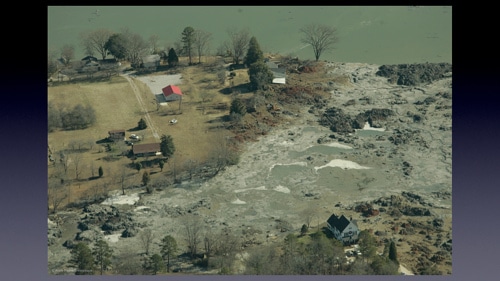The Inspector General of the Tennessee Valley Authority (TVA) released a new report showing that coal ash holding sites at several TVA-owned coal-fired power plants has managed to contaminate groundwater. The report says that chemical concentrations are so high in certain areas that they could pose a serious health risk to residents. Among the chemicals that the Inspector General’s report lists as being found in the water supply were arsenic, cadmium, beryllium, selenium, and vanadium.
While the chemicals found in the water supply show that there is a serious threat to local communities coming from the coal ash repositories, that isn’t the most disturbing part of the report. The real problem is that the TVA knew about the chemicals being leaked into the water supply for at least a decade, and did nothing. The report says that the TVA had found chemicals indicating coal ash leaks in areas in and around Memphis, as well as other sites across Tennessee.
From a report on the IG’s findings:
Arsenic above today’s allowable levels was found repeatedly in a monitoring well on the site, which is in a sensitive location. The plant and its ash ponds lie above a deep, high-quality aquifer that supplies drinking water to Memphis and nearby areas.
TVA quit testing when the EPA tightened its standard — what’s called the Maximum Contaminant Level, the report said. Samples taken before then had showed arsenic levels above the new, higher standard…
The OIG investigation of groundwater contamination at TVA coal ash sites, released June 21, began as a result of questions raised during congressional testimony following the December 2008 ash spill in East Tennessee.
A mountain of damp ash had buckled at TVA’s Kingston plant and 5.4 million cubic yards of the waste, which contains mercury, cadmium, lead, selenium, arsenic and other potentially toxic substances, cascaded into yards, fields and the Emory River.
The findings of the IG’s report echo the findings of a previous report released by the Environmental Integrity Project (EIP) earlier this summer. According to EIP’s report, coal ash containment ponds in 33 different areas across America have been leaking chemicals into the ground as well as water supplies. From a previous DeSmogBlog entry on EIP’s report:
Some areas reportedly had arsenic levels of 94 parts per billion, over 9 times greater than the legally allowed 10 parts per billion. Selenium levels were recorded at over 50 times the legal level at 1,850 parts per billion. Arsenic is a known carcinogen, and poses significant threats to the liver, cardiovascular system, and kidneys when ingested via drinking water. Selenium has been linked to an increase in Type 2 Diabetes, as well as loss of hair and fingernails, digestive problems, and nerve dysfunction.
The EPA also says that the contaminants found in coal ash can easily make their way from holding ponds, where it is usually stored by coal-fired power plants, into the drinking water supply if the holding pond isn’t sufficiently protected and maintained. However, even with upkeep, strong winds and rain can also spread the coal ash beyond the holding ponds. In spite of these findings, the EPA has yet to issue a ruling on whether or not coal ash is a hazardous toxic substance, and Republican-sponsored legislation is making its way through the House of Representatives that would prevent the EPA from being able to regulate coal ash.
The new TVA Inspector General report, coupled with the previous reports on the dangers of coal ash disposal sites, shows that there are very real dangers associated with the handling of coal ash. If the EPA doesn’t act quickly to regulate it as a toxic substance, the coal ash holding sites across the country that aren’t currently leaking chemicals into the environment are ticking time bombs that could easily contaminate their surrounding areas as these other sites have done.
Subscribe to our newsletter
Stay up to date with DeSmog news and alerts







